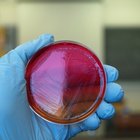margouillatphotos/iStock/GettyImages
Most sauerkraut has a pH of 4.6 or lower. When it is in the 4.0 or lower range, the fermentation is considered successful because that level of acidity safely preserves the food. There are two ways to test the pH of sauerkraut: with a special instrument called a pH meter (sometimes called a pH monitor) or with paper pH test strips (also called litmus paper). Note that sauerkraut is a naturally fermented product that contains live probiotic bacteria. Unless it is heat-processed (canned), its pH may continue to change over time.
Preparing the Sauerkraut for Testing
No matter what method you end up using to test pH, it is important that you first turn the dish into a slurry. You do this by combining both the sauerkraut liquid and its solids in a blender and pureeing them together. Testing the sauerkraut liquid without first blending in the solids will not give you an accurate pH reading.
Testing With a pH Meter
A pH meter uses an electrode immersed in the substance being tested to give a digital readout of its pH. The meter must first be calibrated to a known standard of pH. It must also be calibrated to the temperature of the substance being tested. Precise instructions vary between different models: follow the manufacturer's instructions. PH meters can cost hundreds of dollars, but have the advantage of being much more accurate than pH strips. They are also capable of testing a wider pH range than pH strips.
Testing pH With Paper Test Strips
Paper pH testing strips change color when immersed in the substance being tested. The resulting color indicates the pH of the substance (check the manufacturer's instructions for the specific correlation). Note that although pH strips have the advantage of being inexpensive, they are less accurate than pH meters and can only be used to test substances with a pH of 4.0 or lower. This means that you can use pH testing strips to confirm whether or not the sauerkraut is in the safe food preservation acidity range of 4.0 or less, but cannot get a precise reading during the more alkaline phase of sauerkraut fermentation.
Why Sauerkraut Becomes More Acidic Over Time
The process of making sauerkraut begins with an alkaline brine, usually just salt plus the natural juices of the cabbage. The salt kills off harmful bacteria, but salt-tolerant beneficial bacteria called Lactobacilli survive and cause fermentation to begin. During the fermentation process, the Lactobacilli convert the sauerkraut from an alkaline environment to an acidic one. Because of this active fermentation, the pH of recently made sauerkraut is higher than that which has had several days or weeks to ferment.
Related Articles

How to Measure the Acidity of Homemade ...

How to Test Caffeine in Coffee

Composition of Monosodium Glutamate

Traditional Uses of Cuscuta

How to Cook Pork & Sauerkraut in an ...

Uses of Saltpeter in Food

Liquid Smoke Ingredients

What Are the Dangers of Sauerkraut?

How to Test for Hair Dye Allergies

How to Calculate Alcohol Content in Wine

Difference Between Percent Alcohol & ...

Is Applesauce an Alkaline Food?

Types of Bacteria in Wine

What Is the Durability of Bamboo Fabric?

What Is Agave Syrup?

Does Pineapple Curdle Milk?

What Causes Honey to Ferment?

How to Measure Water Temperature With ...

How to Make Salt Brine

How to Make Grapefruit Seed Extract
References
Writer Bio
Leda Meredith is the author of two books, including "The Locavore's Handbook: The Busy Person's Guide to Eating Local on a Budget." Specializing in wild edible plants, she is also an instructor at the New York Botanical Garden and the Brooklyn Botanic Garden.